Creating a pollinator-friendly garden helps local pollinators and supports a healthy ecosystem. By using native plants, you can attract bees, butterflies, and hummingbirds. A well-designed garden becomes a haven for these vital creatures.
Imagine a garden buzzing with life, filled with the sweet scent of flowers. This is what a pollinator-friendly garden looks like. With the right guidance, you can make this dream a reality in your backyard. The Rhode Island Wild Plant Society, Native Plant Trust, and Ladybird Johnston Wildflower Database are great resources to start.
Choosing native plants for your garden gives food and shelter to native pollinators. This helps the local ecosystem and supports environmental health. Use the USDA guide for Rhode Island and the Audubon Pollinator Alliance to make a difference.
Key Takeaways
- Native plants are essential for supporting local pollinators and creating a healthy ecosystem.
- A well-designed pollinator garden can attract a variety of pollinators, including bees, butterflies, and hummingbirds.
- Planting a diverse array of native plants can attract beneficial insects that help with pollination and pest control.
- Avoiding the use of pesticides, especially insecticides, is crucial for maintaining a pollinator-friendly garden.
- Providing water sources and shelter is essential for creating a pollinator-friendly habitat.
- Native plants, such as oak, elm, milkweed, and grasses, serve as important larval hosts for various butterflies.
Why Pollinators Matter in Your Garden
Pollinators are key to our ecosystem’s health. By making your garden pollinator-friendly, you help keep biodiversity alive. This also ensures we have enough food. To attract pollinators, knowing their role in nature is crucial.
A beneficial insect garden helps fight the decline of pollinators. It gives them homes and food. Since three-fourths of the world’s flowers and 35% of food crops need pollinators, supporting them is vital.
The Role of Pollinators in Ecosystems
Pollinators are behind one of every three bites of food. They are essential for our food supply. Without them, many plants can’t reproduce, leading to less food.
Benefits of Supporting Local Pollinators
Helping local pollinators brings many benefits. These include:
- Increased crop yields
- Enhanced biodiversity
- Creation of vibrant ecosystems
- Attraction of butterflies, bees, and birds
Creating a pollinator-friendly garden helps these vital creatures. It also makes your ecosystem thrive.
| Pollinator | Importance |
|---|---|
| Bees | Responsible for pollinating 1/3 of the world’s crops |
| Butterflies | Important pollinators of flowers and crops |
| Hummingbirds | Key pollinators of tubular flowers |
Choosing the Right Native Plants
Creating a pollinator-friendly garden starts with the right plants. Plant selection for pollinators is key. Native plants need less care, fight off pests well, and feed specialist insects. Think about your local climate and soil when picking plants.
A good pollinator garden design has a mix of plants that do well in your area. Use resources like the Maryland Native Plant Society and Native Plant Finder to find native plants. This way, your garden will be beautiful and help local pollinators.
Understanding Local Climate and Soil Conditions
Knowing your local climate and soil is vital for picking the right plants. Different areas have unique features that affect plant growth. For example, Maryland has mountains, a plateau, and a coastal plain, each with its gardening challenges and opportunities.
Selecting Plants for Different Seasons
To have a thriving pollinator garden, pick plants that offer nectar and pollen all season. Choose plants that bloom in spring, summer, and fall. This variety supports more pollinators.
| Season | Plant Examples |
|---|---|
| Spring | Crocus, Daffodil, Tulip |
| Summer | Black-eyed Susan, Butterfly Bush, Bee Balm |
| Fall | Aster, Chrysanthemum, Sedum |
How to Identify Native Plant Species
Finding native plant species can be tricky, but help is out there. Use online tools like the Native Plant Finder or talk to local nurseries and experts. Choosing native plants makes your garden beautiful and helps local pollinators and beneficial insects.
Creating a Diverse Plant Palette
Creating a pollinator-friendly garden means using a variety of plants. This includes native flowers, trees, and shrubs. They offer food and shelter for pollinators. This variety is crucial for pollinator-friendly landscaping, attracting many beneficial insects like bees and butterflies.
A beneficial insect garden needs plants that bloom at different times. This ensures a steady supply of nectar and pollen for pollinators. Plants like Hyssop, Bee Balm, and Coneflower are great for this. They’re not only pretty but also a rich food source for pollinators.
Trees and shrubs are also key in a diverse garden. They offer shelter and food for pollinators. Lavender, Sunflowers, and Milkweed are excellent choices for trees and shrubs in a pollinator garden.
By having a diverse plant palette, you can draw in many pollinators. This includes bees, butterflies, and hummingbirds. It’s good for the environment and makes your garden more beautiful. So, why not start creating your pollinator-friendly landscaping today?
Designing Your Pollinator Garden Layout
Creating a pollinator garden needs careful planning. A good pollinator garden design welcomes pollinators and keeps them safe. Begin by choosing plants and arranging them thoughtfully. Think about each plant’s size, growth, and space needs.
Pollinator-friendly landscaping means having a variety of plants. This variety ensures flowers bloom at different times. For example, spring flowers like crocuses are followed by summer blooms like daisies. Then, fall flowers like asters and goldenrods come next. This keeps pollinators like bees and butterflies fed all season.
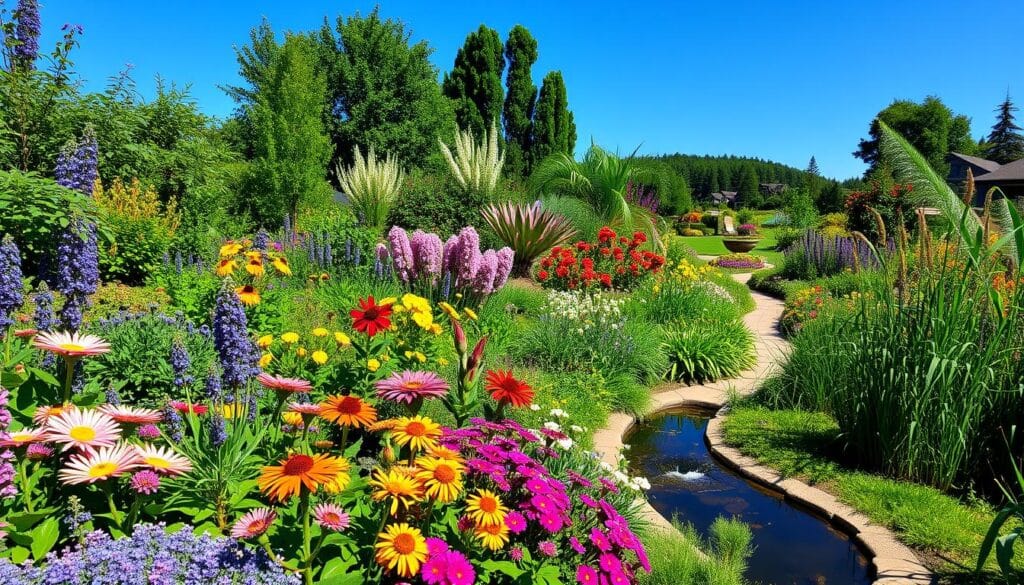
When gardening for bees and butterflies, remember their preferences. Bees like blue, purple, and yellow flowers. Butterflies prefer bright colors like milkweed and zinnias. Adding these plants makes your garden a welcoming place for them.
Here are some tips for your pollinator garden:
- Make microhabitats, like rocky areas or bare ground, for shelter and nesting.
- Include pathways and resting spots, like shallow dishes with stones, for water and perches.
- Use native plants to match your local climate and soil, making your garden easier to care for.
Water Sources for Pollinators
Creating a pollinator-friendly garden means more than just plants. It also needs a reliable water source. Bees and butterflies need water for their health. Bees look for safe water, while butterflies find minerals in wet mud.
Water sources can be simple, like a shallow dish or birdbath. Or, you can have a pond or fountain to attract more pollinators. Items like frisbees and terracotta trays can be used as bee watering stations. You can find handmade stations on Etsy and Uncommon Goods.
An ideal bee watering station has shallow water and natural materials. It should also have organic matter and a tiny bit of salt. This helps native bees and wasps avoid harmful pollutants. Water is also key for bees, as pollen and nectar are dry.
Why Water is Essential for Pollinators
Water is vital for pollinators as a drinking source and for bathing. Many insects and amphibians live in ponds, like dragonflies and damselflies. Mason bees use mud and water for their nests, making many trips a day. Paper wasps also need water to cool their colonies.
Easy Solutions for Adding Water Features
Adding water features to your garden is fun and easy. Start with a shallow dish or birdbath in a sunny spot. Add fresh water and rocks or twigs for landing spots. You can also build a pond or fountain for more pollinators.
- Use a shallow container, like a saucer, with fresh water and rocks or twigs.
- Create a bee watering station with a terracotta tray or handmade station.
- Add a small pond or fountain to your garden.
Maintaining Clean Water Sources
Keeping water sources clean is crucial for pollinators. Change the water often and add rocks or twigs. Avoid harmful chemicals and pesticides. A clean water source supports local pollinators and makes your garden thrive.
Avoiding Harmful Chemicals
Creating a pollinator-friendly garden means more than just picking the right flowers. It’s also about avoiding harmful chemicals that can harm bees and butterflies. This careful approach to pest control and garden care is key.
In a garden for beneficial insects, we aim to attract many pollinators. But pesticides and herbicides can harm our efforts. It’s important to know how these chemicals affect pollinators to make better garden choices.
Understanding Pesticides and Their Impact
Pesticides can be very harmful to pollinators, causing them immediate harm or death. Even when used correctly, these chemicals can pollute soil, water, and air. This poses long-term risks to pollinator health. In a garden friendly to pollinators, finding chemical-free solutions is crucial.
Natural Alternatives to Chemical Treatments
Fortunately, there are natural ways to keep your garden healthy without chemicals. You can introduce beneficial insects, use physical barriers, and keep your garden clean. These methods help reduce chemical use and make your garden safer for bees and butterflies.
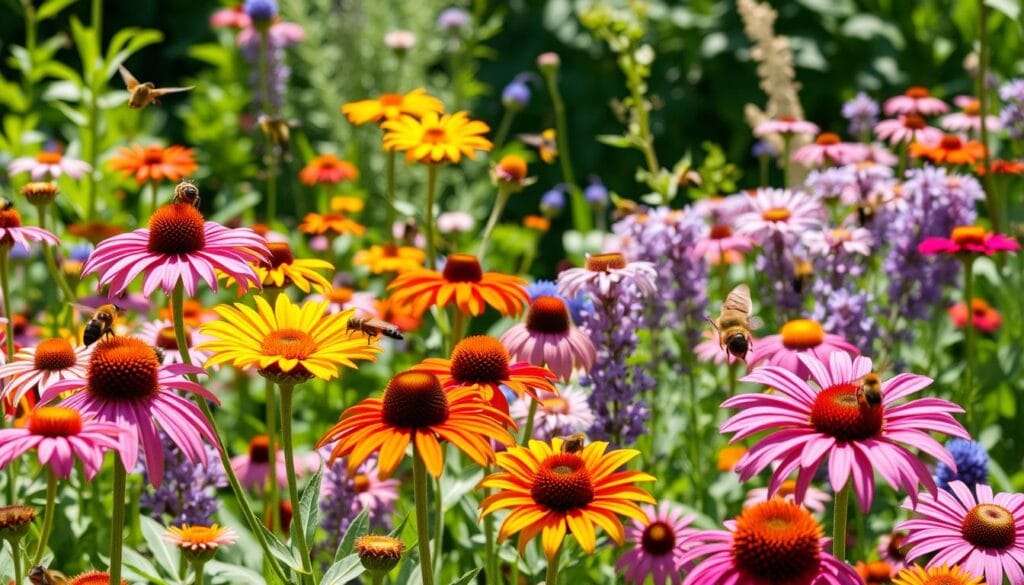
Adopting Integrated Pest Management Practices
Integrated pest management (IPM) is a holistic way to handle pests. It focuses on prevention, observation, and targeted action. This method is perfect for gardens that want to avoid chemicals and support local pollinators. By using IPM, you can keep your garden healthy while helping pollinators thrive.
| Chemical | Impact on Pollinators | Natural Alternative |
|---|---|---|
| Pesticides | Harm or kill pollinators | Introduce beneficial insects |
| Herbicides | Contaminate soil and water | Use physical barriers or mulch |
Seasonal Maintenance for Your Pollinator Garden
Creating a pollinator garden is exciting. But, it’s key to know how to keep it alive all year. A good garden design attracts bees and butterflies, which are vital for our gardens. Regular care makes sure your garden stays a safe spot for these important creatures.
Seasonal care means getting your garden ready for each season’s changes. This includes pruning, fertilizing, and watering. These steps are crucial for a garden that blooms all year and helps local pollinators.
Spring Preparation for Growth
In spring, get your garden ready for new life. Cut back dead or damaged stems to encourage growth. It’s also time to add fertilizers like compost or fish emulsion to help your plants grow strong.
Summer Care to Enhance Health
Summer is for keeping your plants healthy. Make sure to water, weed, and manage pests regularly. Choose organic pest control to keep your garden safe for pollinators.
Fall Activities for Long-Term Success
Fall is for getting your garden ready for winter. Clean up dead plants, add mulch to keep moisture in, and plant cover crops to improve the soil. These steps are important for your garden’s long-term health and success.
- Prune dead or damaged stems to encourage new growth.
- Apply organic fertilizers to promote plant health.
- Use mulch to retain moisture and suppress weeds.
- Consider planting cover crops during the off-season.
Attracting Various Types of Pollinators
To make a garden friendly for pollinators, you need to attract bees, butterflies, and hummingbirds. Choose plants that draw in different pollinators. This makes your garden a welcoming place for them.
For a garden that helps bees and butterflies, pick the right plants. Make sure to provide what they need. This way, you can create a space that’s good for beneficial insects.
When planning your garden, pick plants that bloom at different times. Choose flowers in various colors and shapes. This will bring more pollinators to your garden.
Here are some tips to attract pollinators:
- Make butterfly feeders and hummingbird feeders.
- Provide shallow dishes with water and rocks.
- Plant native plants like Alyssum, Aster, and Bee balm for butterflies.
- Include plants like Agastache, Bee balm, and Canna for hummingbirds.
- Add flowers with flat-topped features, like Allium, Aster, and Basil, for bees.
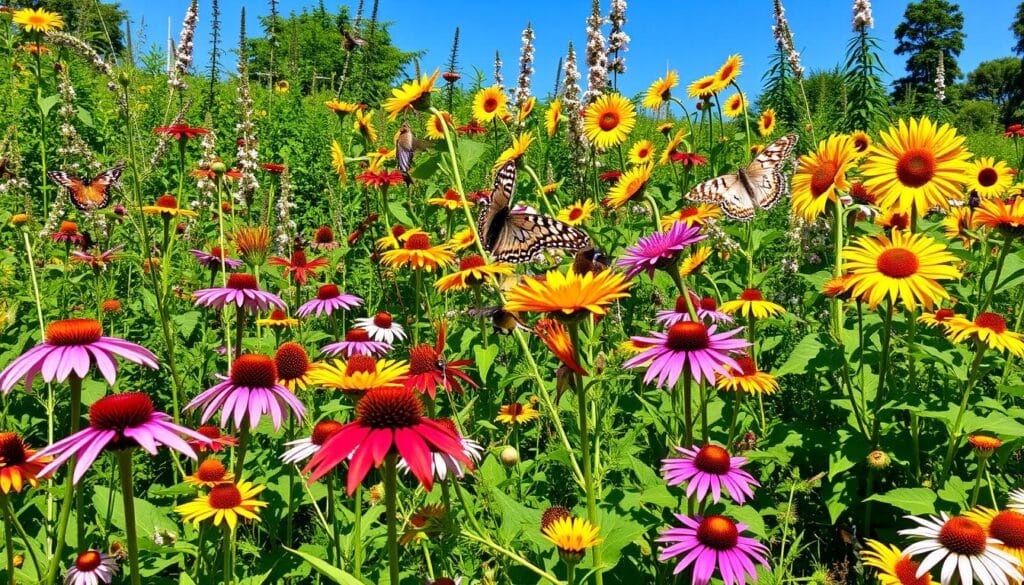
Bees: Essential Pollinators
Bees are key pollinators, but their numbers are falling. This is due to habitat loss, climate change, and pesticides. By creating a garden for beneficial insects, you can help bees.
Butterflies: Colorful Visitors
Butterflies like flowers with flat or tubular shapes, especially in red, orange, yellow, or pink. It’s important to offer food for caterpillars to support butterflies.
Hummingbirds: Dynamic Helpers
Hummingbirds are drawn to red, orange, and pink flowers with tubular shapes. Adding these plants to your garden can attract hummingbirds.
By following these tips, you can create a garden that helps pollinators. This supports local populations and makes your ecosystem healthier.
| Pollinator | Attracted to | Tips for Attraction |
|---|---|---|
| Bees | Flat-topped flowers, blues and purples | Plant native plants, avoid pesticides |
| Butterflies | Flat-topped or tubular flowers, red, orange, yellow, or pink | Provide food sources for caterpillars, create butterfly feeders |
| Hummingbirds | Vibrant red, orange, and pink flowers with tubular shapes | Install hummingbird feeders, plant native plants |
Engaging Your Community with Your Garden
Creating a pollinator-friendly garden can make a big difference in your community. By sharing your knowledge, you help protect pollinators and build connections. A garden for beneficial insects can be a place where people come together to learn and share.
Getting your neighbors involved in gardening can strengthen community bonds. You can organize workshops to teach about pollinators and gardening. Sharing your garden’s journey on social media can also inspire others and unite your community.
- Hosting a garden tour or open house to showcase your pollinator-friendly garden
- Creating a community garden or green space where people can come together to garden and learn
- Partnering with local organizations or schools to promote pollinator conservation and education
Together, you can build a network of gardens that support biodiversity. This helps protect vital species like bees and butterflies.
Expanding Your Pollinator-Friendly Efforts
As you grow your pollinator-friendly garden, think about making a bigger impact. This helps keep biodiversity alive and pollinators healthy for the future. One way is to make a pollinator corridor by linking your garden to others nearby.
Work with local groups and push for policies that help pollinators. You can join local gardening clubs or conservation groups. Also, support laws that protect natural places like meadows and forests, which pollinators need.
Creating a Pollinator Corridor
A pollinator corridor is a chain of habitats that lets pollinators move safely. Plant native wildflowers along roads, parks, and public areas. This boosts pollinator numbers and helps the local ecosystem.
Collaborating with Local Organizations
Team up with local groups to grow your pollinator efforts. Work with gardening clubs, conservation groups, or community centers. This spreads the word about pollinators and encourages others to act.
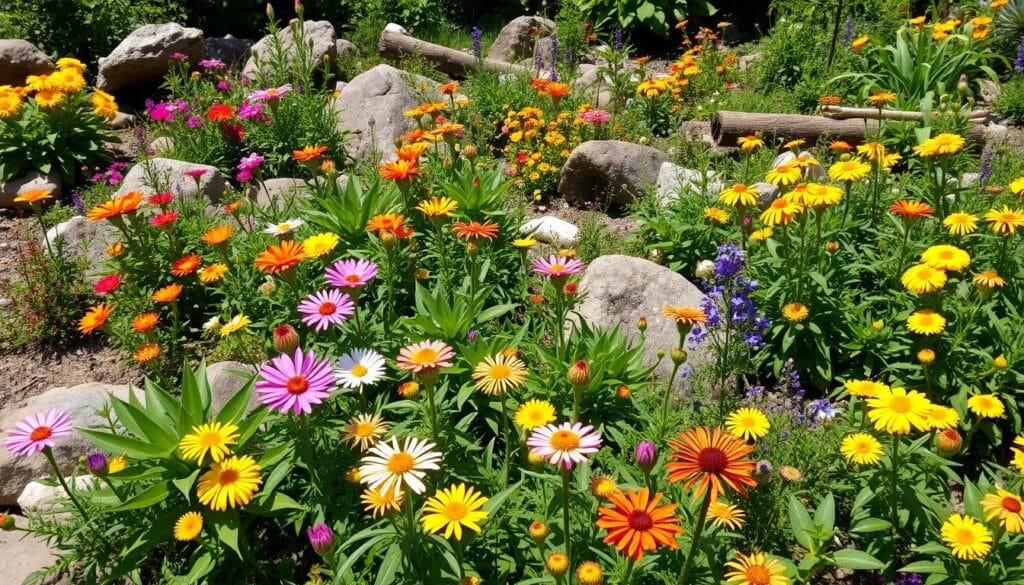
- Local gardening groups
- Conservation organizations
- Community centers
- Parks and Recreation departments
Together, you can build a community that supports pollinators. Every small step helps a lot, and expanding your efforts can make a big difference. Start by making a pollinator corridor, teaming up with local groups, and pushing for pollinator policies. With your help, we can ensure pollinators thrive, keeping our ecosystems healthy and strong. This is key for gardening for bees and butterflies and maintaining a beneficial insect garden through pollinator-friendly landscaping.
Monitoring and Evaluating Your Garden’s Health
As you set up your pollinator garden, it’s key to watch its health closely. Keep an eye on pollinator visits, plant growth, and diversity. Adjust your garden as needed to make it a great home for pollinators.
When you garden for bees and butterflies, plant diversity is crucial. Different plants draw in different pollinators. So, a garden with many plants will attract more species. You can track this by:
- Tracking the blooming periods of different plants
- Noting the types of pollinators that visit each plant
- Monitoring plant health and adjusting your care routine as needed
By checking your garden’s health and tweaking it, you can make sure it thrives. This might mean adding new plants, changing your watering schedule, or adding features like water or windbreaks.
A healthy pollinator garden is always changing and needs constant care. By watching its health, you can make a welcoming space for pollinators. And you’ll enjoy the many perks of a pollinator-friendly garden.
| Plant Type | Pollinator Attracted | Blooming Period |
|---|---|---|
| Butterfly Bush | Butterflies, Bees | Summer |
| Lavender | Bees, Butterflies | Summer |
| Coneflower | Bees, Butterflies | Summer, Fall |
Resources and References for Garden Enthusiasts
Starting a
is exciting. You’ll need reliable resources and a supportive community. Whether you’re new or experienced, many
books, forums, and local services can help.
Recommended Books and Guides
For more on
design, check out “Pollinator Friendly Gardening” by Rhonda Fleming Hayes. Also, “The Humane Gardener” by Nancy Lawson and “Bringing Nature Home” by Douglas W. Tallamy is great. They teach about native plants, diverse habitats, and pollinators’ roles in your garden.
Online Communities and Forums
Joining online communities is a good idea. It’s a chance to share, ask, and get inspired. Look for groups like the Pollinator Partnership or the Colorado State University Garden Ecology Lab. They’re full of knowledge and support.
Local Extension Services for Support
Local extension services are also valuable. They offer advice and resources for your area. Experts there can guide you on the best
practices and plant choices.
Using these resources, you can grow your knowledge and skills. Your garden will become a haven for pollinators. Enjoy watching your garden come to life with buzzing and fluttering.
FAQ
What are the benefits of having a pollinator-friendly garden?
Creating a pollinator-friendly garden supports local pollinators and helps maintain a healthy ecosystem. It also promotes biodiversity and plays a crucial role in food production by supporting pollination processes.
How do I choose the best plants for my pollinator garden?
Choose native plants that are suited to your local climate and soil conditions. Opt for plants with varying bloom times to provide a continuous food source throughout the seasons.
How can I encourage pollinators to visit my garden?
To attract pollinators, provide a variety of nectar-rich flowers, offer water sources, and create shelter with native plants. Also, avoid using harmful chemicals that may deter pollinators.
How can I reduce the use of harmful chemicals in my garden?
Avoid synthetic pesticides and herbicides. Use organic pest control methods, such as introducing beneficial insects, using neem oil, or practicing crop rotation to reduce the need for chemicals.
What seasonal care does my pollinator garden need?
During spring, prepare the garden by clearing debris and planting early bloomers. In summer, keep the garden hydrated and well-maintained. In fall, allow seed heads to remain for birds and pollinators, and perform any necessary pruning.
What resources can help me learn more about pollinator gardens?
Look for online guides, local gardening centers, books, and community forums. Many extension services offer resources tailored to your region’s climate and native plant species.
Source Links
- Creating Pollinator Habitat : Pollinators : Audubon Society of Rhode Island – https://asri.org/pollinators/creating-habitat.html
- How To Create a Pollinator Garden | Mulhall’s – https://mulhalls.com/garden-home/blog/how-to-create-a-pollinator-habitat/
- Why Are Pollinator Gardens Important? Exploring Fascinating Pollinator-Friendly – https://tascllc.com/en/blog/why-are-pollinator-gardens-important-exploring-fascinating-pollinator-friendly-131?srsltid=AfmBOor9t6u3e9GUyrgA_GDDnDdEhjPIfHkZGYt_zIh6QxAUi0UaoZca
- Why Pollinators Matter: How to Help Declining Pollinator Populations – https://zerowastehomestead.com/why-pollinators-matter-whats-behind-the-insect-decline-and-what-to-do-about-it/
- How to Create an Indoor-Outdoor Garden Oasis –
- The Power of Pollination, Why It Matters 🐝🦋🐦⬛ Reston Farm Garden Market – https://restonfarm.com/the-power-of-pollination/
- Pollinator Gardens | University of Maryland Extension – https://extension.umd.edu/resource/pollinator-gardens
- Create a Pollinator-Friendly Garden – https://washoecounty.gov/sustainability/take-action/pollinator-friendly-garden.php
- How to Create a Pollinator Garden – Dennis’ 7 Dees | Landscaping Services & Garden Centers – https://dennis7dees.com/creating-a-pollinator-garden/
- Creating A Pollinator-Friendly Garden – Holly Days Nursery, Garden Center, & Landscaping – https://hollydaysnursery.com/creating-a-pollinator-friendly-garden/
- How to Create a Pollinator-Friendly Garden: A Complete Guide – https://harvestsavvy.com/pollinator-friendly-garden/
- How to Build a Pollinator-Friendly Garden – https://savannahbee.com/blogs/the-latest-buzz/how-to-build-a-pollinator-friendly-garden?srsltid=AfmBOopCvpFuuloEyS-2BnvDVerhyGBSe24jIpktOWtjGq0NlgqwDjvb
- Urban Pollinator Gardens: Design Guide 2024 – https://www.thrivelot.com/resources/urban-pollinator-gardens-design-guide-2024
- Create Your Own Native Pollinator Garden – https://suwater.stanford.edu/water-efficiency/water-wise-garden/create-your-own-native-pollinator-garden
- If You’re Thirsty, They’re Thirsty: Make a Simple Water Source To Support Pollinators – https://www.xerces.org/blog/if-youre-thirsty-theyre-thirsty-make-simple-water-source-to-support-pollinators
- an essential component of bee gardening – https://www.ecofriendlyhomestead.com/sustainable-garden/learn/bee-water-stations-an-essential-component-of-bee-gardening
- Attract Bees, Butterflies, and Other Pollinators to Your Yard with These Expert Tips – https://www.forksoverknives.com/how-tos/attract-pollinators-to-your-yard-expert-tips/
- 10 Ways to Save the Bees – The Bee Conservancy – https://thebeeconservancy.org/10-ways-to-save-the-bees/
- Establish a Garden Pollinator Paradise for Bees, Butterflies, and Birds – Wall & Company – https://wallandcompany.com/attract-garden-pollinators/
- Maintaining and Feeding Your Pollinator Garden – Town & Country Nurseries – https://townandcountryhaddam.com/2024/05/20/maintaining-and-feeding-your-pollinator-garden/
- Essential Pollinator Gardening: A Beginner’s Guide – https://www.bathgardencenter.com/post/pollinator-gardening
- Want to Save the Bees? How to Create a Pollinator Garden Where They’ll Thrive – https://www.thespruce.com/how-to-create-your-own-pollinator-garden-8628809
- How Can We Help Pollinators?: Tips to Draw Bees and Other Pollinators – https://zerowastehomestead.com/how-to-attract-pollinators-to-your-garden/
- How to Attract Pollinators | Gardener’s Supply – https://www.gardeners.com/how-to/attracting-butterflies-hummingbirds/7265.html?srsltid=AfmBOoqiJWqxbDCSjd0tlTvVi-zPlCh6I6pU2Sf8bliOtiVJg97EUhxM
- Pollinator Week Activities | Pollinator.org – https://www.pollinator.org/pollinator-week/activities
- Pollinator Garden – https://www.mrsdavidsgardenseeds.com/pollinator-garden.html
- Pollinator Conservation Program – https://www.xerces.org/pollinator-conservation
- Pollinator-friendly planting guide | Minnesota Environmental Quality Board – https://www.eqb.state.mn.us/programs/pollinators/pollinator-friendly-planting-guide
- Assess Your Garden Conditions – https://home.howstuffworks.com/gardening/garden-design/assess-your-garden-conditions.htm
- Funding Opportunities for Small-Scale Pollinator Habitats: A Guide for Urban and Home Garden Projects – https://extension.sdstate.edu/funding-opportunities-small-scale-pollinator-habitats-guide-urban-and-home-garden-projects
- How to Create a Pollinator Paradise 🐝🦋🐦⬛ Reston Farm Garden Market – https://restonfarm.com/how-to-create-pollinator-paradise-zone-7/
- Garden Design – Garden Ecology Lab – https://blogs.oregonstate.edu/gardenecologylab/category/garden-design/
- Pollinators – Denver Gardeners – https://denvergardeners.wordpress.com/tag/pollinators/


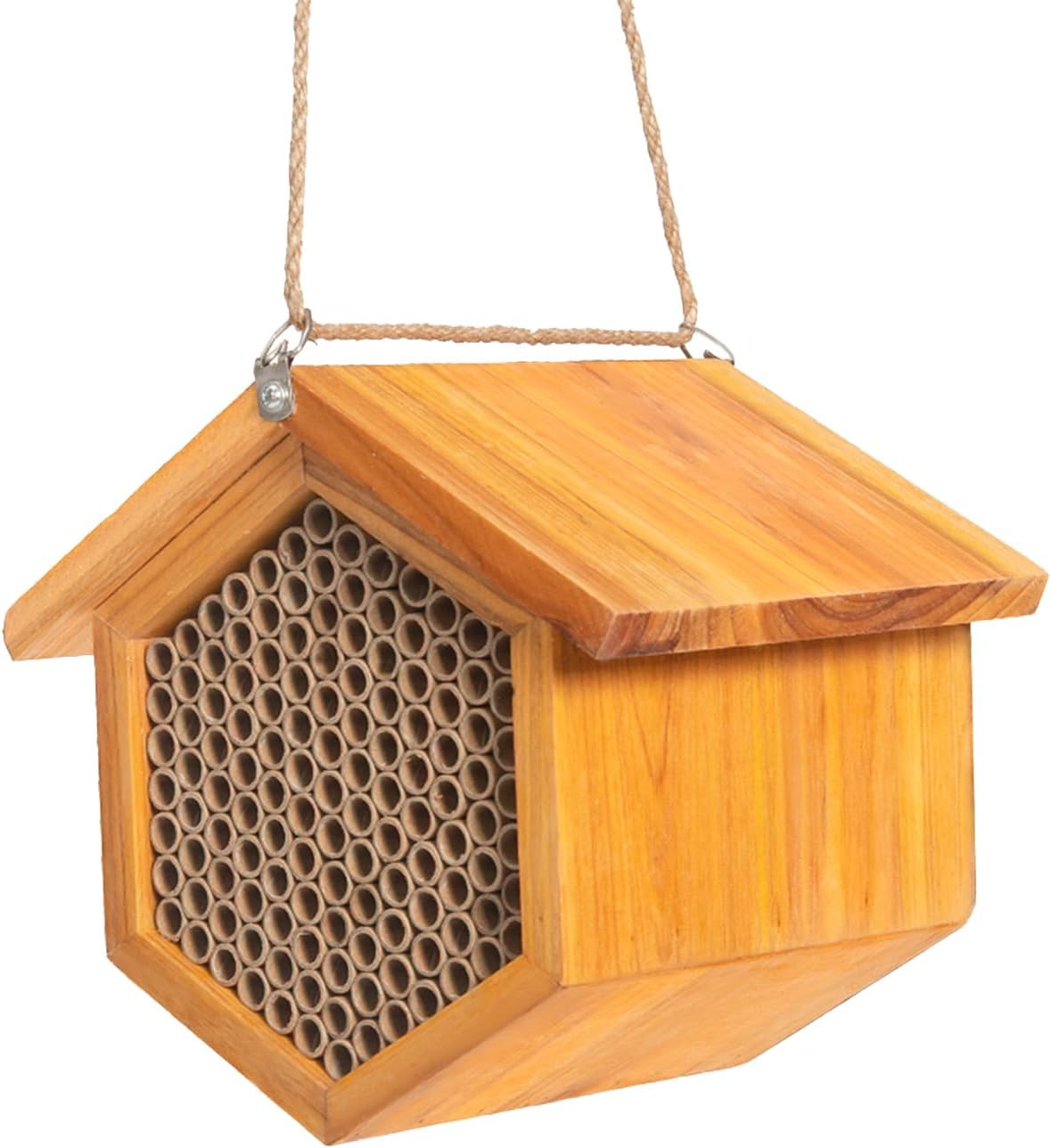

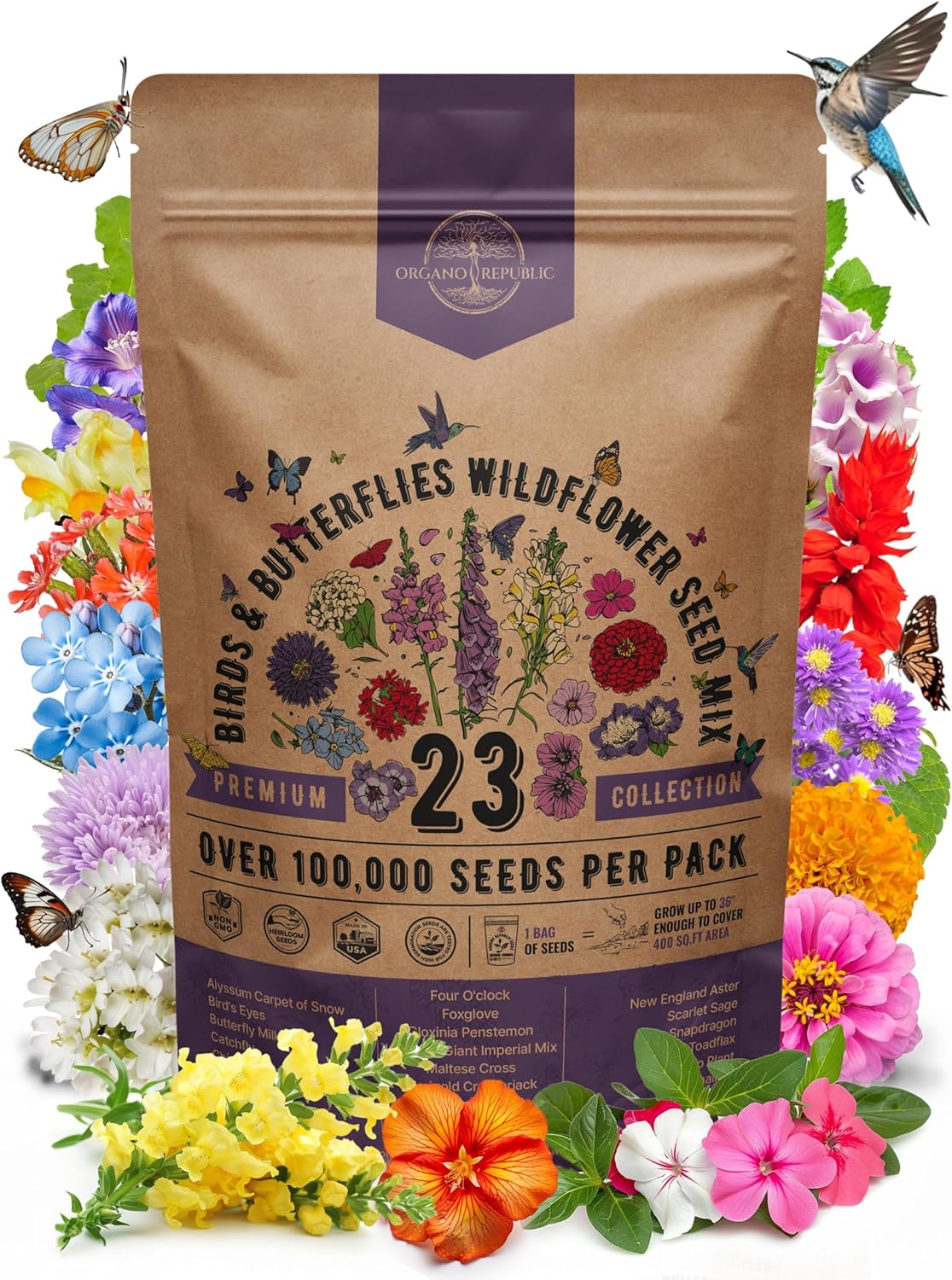

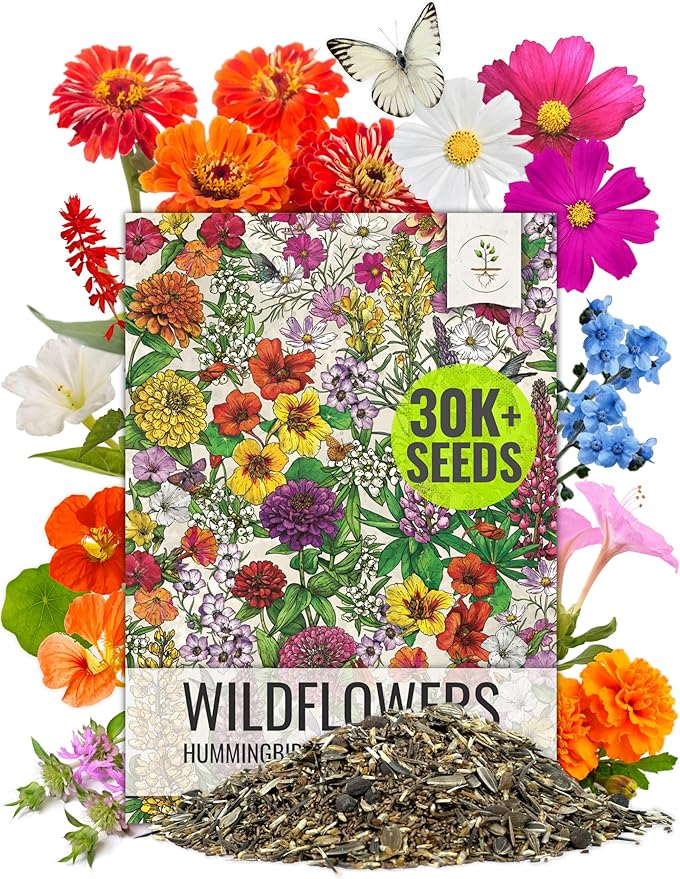
Pingback: 10 Stunning Perennial Flowers That Bloom Year After Year